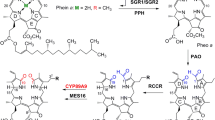Abstract.
Leaf senescence is accompanied by the metabolism of chlorophyll (Chl) to nonfluorescent catabolites (NCCs). The pathway of Chl degradation comprises several reactions and includes the occurrence of intermediary catabolites. After removal of phytol and the central Mg atom from Chl by chlorophyllase and Mg dechelatase, respectively, the porphyrin macrocycle of pheophorbide (Pheide) a is cleaved. This two-step reaction is catalyzed by Pheide a oxygenase and RCC reductase and yields a primary fluorescent catabolite (pFCC). After hydroxylation and additional species-specific modifications, FCCs are tautomerized nonenzymically to NCCs inside the vacuole. Different subcellular compartments participate in Chl catabolism and, thus, transport processes across membranes are required. This review focuses on the catabolites and the individual reactions of Chl breakdown in higher plants. In addition, the pathway is compared to Chl conversion to red catabolites in an alga, Chlorella protothecoides. Finally, the significance and regulation of Chl degradation are discussed.
Similar content being viewed by others
Author information
Authors and Affiliations
Additional information
Received 10 March 1999; received after revision 6 May 1999; accepted 12 May 1999
Rights and permissions
About this article
Cite this article
Hörtensteiner, S. Chlorophyll breakdown in higher plants and algae. CMLS, Cell. Mol. Life Sci. 56, 330–347 (1999). https://doi.org/10.1007/s000180050434
Issue Date:
DOI: https://doi.org/10.1007/s000180050434




